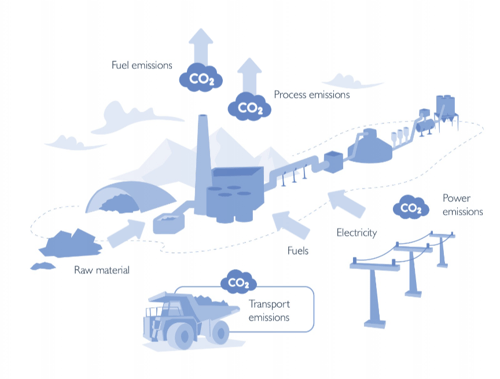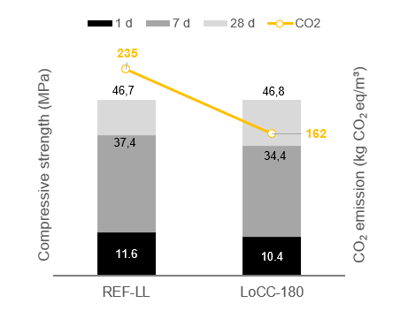It’s an inescapable fact that concrete is the most widely used manufactured material in the world. Thanks to its durability, strength, ease of processing and almost unlimited availability, more than 10 billion tons of concrete are produced each year1 with a carbon footprint to match. Even small amounts of concrete admixtures have a significant impact on the final properties of concrete with a negligible impact on the environment and can save more than 30% of CO2 emissions compared to today’s standard concrete. It is therefore essential that we explore their potential in relation to the decarbonization of concrete.
Where do the carbon emissions of concrete come from?
In its simplest form, concrete consists of cement, sand, aggregates and water. The most used cement is Portland cement, which consists of over 90% of cement clinker 2.
Cement clinker production results in significant CO2 emissions. The majority of these – around 65% – are process emissions released when the limestone is burned and converted into lime, releasing CO2 3. These process emissions are unavoidable as they are the result of a chemical reaction.
The remaining emissions are mainly caused by generating the energy needed to achieve the extreme process temperature of 1450 °C and, to a smaller extent, the energy required for grinding and transport, although these emissions can be offset by using green energy sources.

Steps to help achieve net zero in construction
The sustainable transformation of concrete construction is a critical factor towards achieving the ambitious sustainability goal of greenhouse gas neutrality by 2050. The more efficient use of raw materials, the re-use or recycling of concrete elements and the decarbonization of concrete will considerably change processes throughout the entire value chain and will significantly reduce the carbon footprint of the construction industry. However, measures to decarbonize concrete should ideally not cut the durability and excellent mechanical properties of conventional concrete.
Possible approaches to address the reduction of CO2 emissions:
- The use of renewable energy in clinker and cement production
- The capture and storage/use of CO2 emitted during cement production
- The use of supplementary cementitious materials (SCM) to replace cement clinker, e.g. ground granulated blast furnace slag or calcined clay in the production of cement
- The reduction of the cement content in concrete by using SCMs or fillers such as limestone
One key technology to realize a higher use of SCMs in cement or concrete and/or to decrease the cement content in concrete is the use of specially developed admixtures.
Addressing the CO2 challenge with admixtures
The technical limitations of clinker and cement substitution are determined by:
- The workability of the concrete mix prior to curing (SCM and fillers do not disperse as well as cement)
- The decrease in strength that the use of SCMs cause in hardened concrete
- The effects of SCMs on the durability of concrete
Concrete admixtures can compensate for these shortcomings: Water reducers optimize particle dispersion and concrete flow properties; accelerators boost concrete strength development and various agents can be used to improve durability.
Therefore, the greater the degree of clinker and cement substitution the higher the potential for the exploitation of admixtures to optimize the CO2 footprint of concrete while maintaining performance in terms of workability, strength and durability. In addition, the future costs of CO2 emissions will steadily increase, and admixtures will enable us to keep them at a minimum.
How far can admixtures reduce CO2 emissions?
When the water content of concrete increases the workability is improved but the strength of the hardened concrete decreases. The use of water-reducing admixtures makes it possible to decouple strength development from workability, i.e., if the water content is reduced, workability can be kept at the same level while increasing concrete strength. In the late 90’s, the development of MasterGlenium SKY water reducers from Master Builders Solutions achieved a new level of water reduction without the loss of workability in so-called self-compacting concrete. This protected workers from vibrations during concrete placement and additionally reduced the cement content of concrete without a loss of strength. For example, this saved around 7-15% of cement and the associated CO2 emissions in a standard precast concrete containing CEM II/A cement.
If we use more SCMs to further reduce CO2 emissions, concrete will become increasingly “sticky” and maintaining workability will be a challenge. The latest water-reducing technologies (e.g. MasterEase, MasterSure) have been developed to perfectly compensate for this dilemma. They enable the efficient mixing and placement of concrete using diverse quality of raw materials and under fluctuating environmental conditions to provide reliable and robust concrete.
However, the limited strength contribution of SCMs requires further measures to achieve the desired concrete strength. By using accelerators the hydration of the cementitious phases is boosted so that both early and late strength performance are achieved at the desired level. The combined use of water reducers and accelerators can further reduce CO2 emissions by 10-15% in standardized concrete formulations and 20% in individually approved real low carbon concrete (LoCC) formulations if both cement and water (minimum of 130 l/m³) can be simultaneously reduced. The result would be a total CO2 reduction potential of more than 30% compared to a current standard concrete mix.
 |
 |
Addressing the barriers to levering the full potential of admixtures to reduce CO2 emissions
As with any major improvement in approach, obstacles must be navigated around, and mindsets needs to change. To make a significant difference to CO2 emissions in concrete, there are three key challenges which must be overcome:
- Building regulations: National and regional building standards regulate the minimum cement content of concrete. Technically feasible lower cement-share concrete mixes require individual approvals which is a time-consuming process.
- Real-world construction site considerations: To avoid mix-ups, construction companies often prefer a standard concrete mix to reduce the risks associated with the use of optimized individual solutions for specific applications.
- Lack of awareness throughout the construction value chain: Knowledge of the available solutions, material properties and costs need to be made more widely available to architects, specifiers and contractors.
The admixture solutions which improve the environmental impact of concrete already exist. With the commitment of the construction industry and regulatory bodies, we can all make the most of this chance to reduce carbon emissions.
Want to find out more about decarbonizing concrete through the use of admixtures? Contact our expert Jürgen Bokern, Global Segment Manager Sustainable Concrete, or visit our dedicated page about sustainable concrete here.
References:
1. C. Meyer, “Concrete Materials and Sustainable Development in the United States”, http://www.columbia.edu/cu/civileng/meyer/publications/publications/83%20Concrete%20Materials%20and%20Sustainable%20Development.pdf, retrieved on April 12, 2022, p.1.
2. World Business Council for Sustainable Development, “The Cement Sustainability Initiative”, http://docs.wbcsd.org/2009/06/CementIndustryEnergyAndCO2Performance.pdf, retrieved on April 12, 2022, p.21.
3. European Commission, “Deep decarbonisation of industry: The cement sector”, https://ee-ip.org/fileadmin/user_upload/IMAGES/Articles/JRC120570_decarbonisation_of_cement__fact_sheet.pdf, retrieved on April 12, 2022, p.1
.


